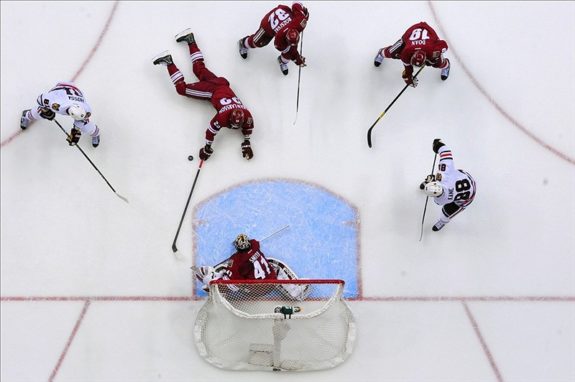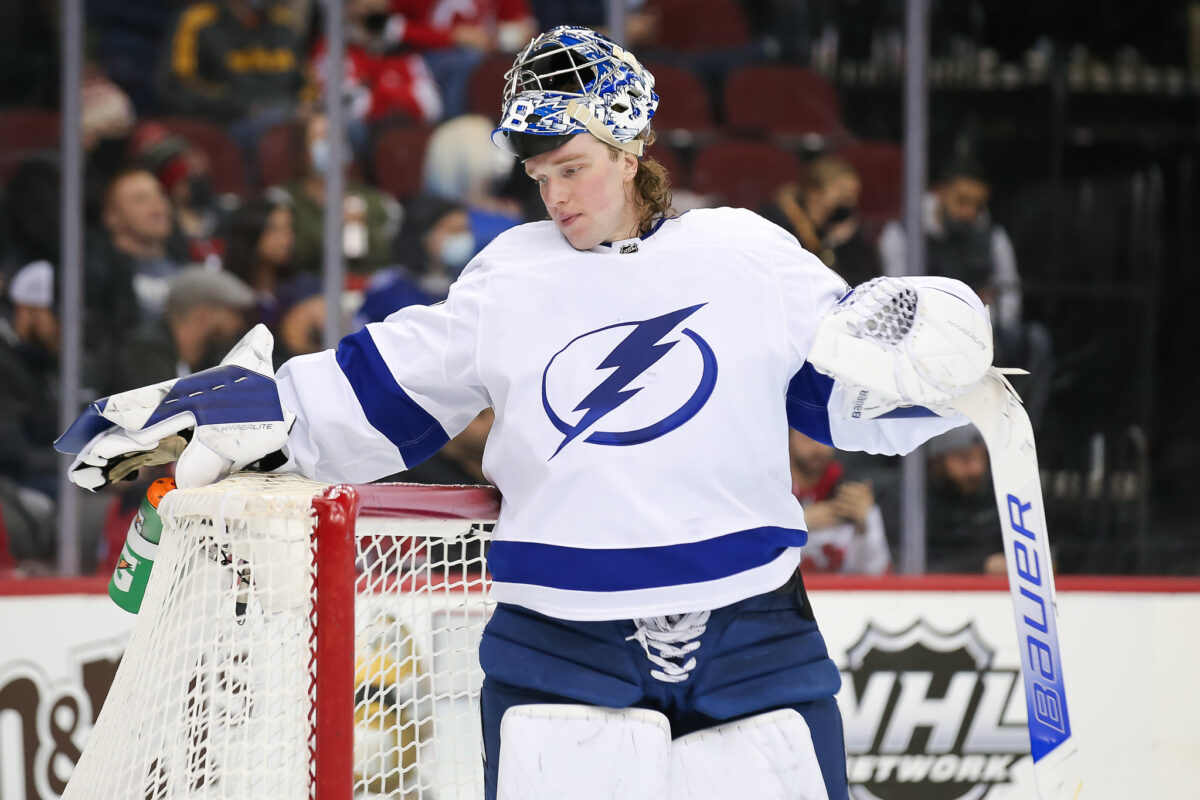In the modern-day NHL, it is significantly easier to analyze goaltenders thanks to the development of advanced analytics, such as goals saved above expected (GSAx) that try to factor out contributions from team defense and isolate the netminder. Since GSAx was only first made available in the 2008-09 season, which goaltenders have had the best individual seasons from that point on?
Tim Thomas (2010-11)
Tim Thomas’ 2010-11 NHL season is one of the most memorable in recent memory. The analytics back up a dominating season that saw him lead the regular season and playoffs in both save percentage (SV%) and GSAx.

In 2009-10, Thomas was relegated to the backup role in the postseason after finishing with a minus-13.7 GSAx in the regular season. In said season, his Boston Bruins became the third team in NHL history to have a 3-0 lead in a playoff series and not end up advancing. His 2010-11 campaign not only revived his career but also the Bruins as a whole. He led the league in GSAx by a long shot with a total of 39.6 in just 55 starts. A .938 SV% and a league-leading 2.00 goals-against average (GAA) helped give him a 35-11-9 record and a Vezina Trophy to boot.
Thomas didn’t miss a beat in the playoffs, holding a .940 SV%, a 1.98 GAA, and a 9.1 GSAx. Leading the Bruins to their first Stanley Cup since 1971-72, his run will be remembered for quite a while.
Mike Smith (2011-12)
It may come as a surprise, but Mike Smith actually had the second-best overall season of the GSAx era. Not only did he finish as the best goaltender in the regular season for the category, but in the playoffs as well. His 2011-12 campaign remains one of the greatest ever.

The Arizona Coyotes got a few elite seasons out of Smith, and they made the most out of it when he was at his absolute best. Even though the team finished in the middle of the pack in goal scoring, his sensational 38-18-10 record combined with a .930 SV% and a 2.21 GAA in the regular season gave them their first and only division title in their entire franchise history, dating back to the old Winnipeg Jets. His 32.3 GSAx led the NHL that season and gave the club confidence that they could win a playoff series for the first time since leaving Winnipeg after the 1995-96 season.
The playoffs that season saw the Coyotes go the furthest they have in team history to date, where they appeared in the Western Conference Final against the Los Angeles Kings. They eventually fell to the team in five games, but it was not due to Smith’s failures. His playoff statistics including a GSAx of 17.9, a .944 SV%, and a 1.99 GAA easily made him the most valuable player on his team, with the highest goal-scorer in the postseason finishing with just five goals. For his efforts, he finished in fourth place in Vezina Trophy voting. It could be argued that he should have won it that season.
Jonathan Quick (2011-12)
Jonathan Quick’s spectacular 2011-12 campaign gave the Los Angeles Kings their first Stanley Cup and established him as one of the greatest goaltenders of the 2010s. Finishing second in the NHL in regular season and playoff GSAx, his season was analytically dominant.

The Kings, finishing as the eighth seed in the 2011-12 Western Conference playoffs, needed every win they could get to even have a chance at the Stanley Cup. Quick’s 31.8 GSAx, .929 SV%, and 1.95 GAA helped the team in their quest. With a wins above replacement (WAR) of 5.30, this essentially means that the club would have likely had around 10 fewer points than they did if they simply had an average-producing player in goal. This was the difference, as he cruised through the playoffs with a 16-4 record and a 14.7 GSAx. His .946 SV% and 1.41 GAA in those playoffs topped off with a Conn Smythe Trophy is still arguably the best performance a goaltender has ever had in a postseason.
Tuukka Rask (2012-13)
Since the 2012-13 NHL season was shortened to just 48 games due to a lockout, it is hard to analyze netminders from that time period accurately. Whether his numbers are adjusted for that or not, Tuukka Rask had arguably the best season of his career in the lockout season.

Rask’s 19.2 GSAx was second in the NHL, yet he only held a 19-10-5 record on the season. A .929 SV% coupled with a 2.00 GAA helped the Bruins rank third in the league for the least amount of goals against and clinch a playoff spot with championship aspirations. He really came into his own once the playoffs hit, leading the way in GSAx with 16.1 and holding a .940 SV% and 1.88 GAA. He helped the Bruins advance to the Stanley Cup Final where they eventually lost to the Chicago Blackhawks in six games by no fault of his own.
Andrei Vasilevskiy (2020-21)
Consistently great goaltending through both the regular season and the playoffs took a hit for quite a while. Many of the best goaltending performances of the analytical era occurred at the turn of the 2010s, and Andrei Vasilevskiy started that off with the best all-around season of his NHL career.

Despite being in a shortened season with completely different divisions, Vasilevskiy was still at the top of his game. He finished second in the NHL in GSAx with 18.2 in just 42 games. His .925 SV% and 2.40 GAA are actually the worst to this point, but the analytics help back his play. He was unable to win the Vezina Trophy that season, but he did come very close.
Vasilevskiy was on a completely different level when the playoffs hit, holding a league-best .937 SV% and a 1.90 GAA. His GSAx for the playoffs was an astounding 26.6, and the current best in the history of the statistic by a wide margin. The second-place leader, which is himself, had 20.8 in 2019-20. He unsurprisingly won the Conn Smythe after he was able to lead his Tampa Bay Lightning to their second-straight Stanley Cup.
Igor Shesterkin (2021-22)
Since GSAx started being tracked in 2008-09, there has been no better goaltender across both the regular season and the playoffs than Igor Shesterkin in 2021-22. Not only was he well deserving of the Vezina Trophy that he captured that season, but was arguably snubbed from the Hart Trophy as well.

Shesterkin led the New York Rangers to a rather unprecedented 52-win season with 36 of his own. He led the league in all of the major goaltending categories with a .935 SV%, 2.07 GAA, and a GSAx of 34.1. Ordinarily, it is not easy to translate play of that degree into the postseason, but that’s exactly what the netminder did. He once again led in GSAx with 18.6, but had a .929 SV% and a 2.59 GAA. He was the backbone of the Rangers’ team, but they unfortunately fell short to the Lightning in the Eastern Conference Final that season.
Andrei Vasilevskiy (2021-22)
Once again making an appearance, Vasilevskiy had one of the more underappreciated seasons in recent history. His .916 regular season SV% and 2.49 GAA don’t demonstrate one of the best seasons in the last 15 seasons, but that’s exactly what it was.
Related: Andrei Vasilevskiy On-Pace to Be an All-Time Great Goaltender
Vasilevskiy finished only second in GSAx behind Shesterkin in 2021-22. In many other seasons, his 28.4 regular season GSAx would be grounds for a Vezina Trophy. Since voters put a primary focus on more basic statistics, he finished just fifth in voting for the award. He continued to be fantastic in the playoffs where he had a 15.5 GSAx that also finished in second place. The benefit of advanced statistics is that it helps his great campaign be recognized. A .922 SV% and a 2.52 GAA in the playoffs have been done by many before, but the Lightning netminder had his work cut out for him as exemplified by his phenomenal GSAx numbers. His efforts helped lead Tampa Bay to their third consecutive trip to the Stanley Cup Final, but they were bested by the Colorado Avalanche.
Juuse Saros (2022-23)
Juuse Saros is the unluckiest player on this list, being the only netminder to have not made the playoffs with a historical regular season effort. Actually, this helps promote his case, as all of the goaltenders above have needed a colossal playoff effort to achieve the analytical totals that he did.

His .919 SV% and 2.69 GAA are not fantastic, but his GSAx absolutely is. Saros finished first in the league with the best regular season GSAx ever recorded, with a total of 46.7. For reference, Thomas held this record for over ten years with a total of 39.6. With a WAR of 7.78 and the Nashville Predators having 92 points on the year, they would have fallen to just 77 if the goaltender were to have had an average season. Playoff excellence is essential, but he was completely robbed of that partially due to some bad injury luck.
Ilya Sorokin (2022-23)
Ilya Sorokin is the second of three netminders to appear on this list from the 2022-23 season alone. His play was truly great, even though he does not rank first in any specific category. Finishing third and fifth in the regular season and playoffs for GSAx respectively, he definitely did not benefit from the goaltenders around him flourishing, although his pockets might have.

Sorokin’s .924 SV% and 2.34 GAA are indistinguishable from other less elite performances until GSAx is brought into play. With a total of 38.7, he also was on the brink of breaking the previous season-high record of 39.6. This garnered some Vezina Trophy attention, but he finished second in voting.
He played at a very similar level in the postseason, but Sorokin’s New York Islanders were bested by the Carolina Hurricanes in six games. A .924 SV%, 2.60 GAA, and 3.7 GSAx certainly cannot be blamed on him. He was the main reason why the team was there, but offensive production was a bit of an issue.
Linus Ullmark (2022-23)
Linus Ullmark caps off what is arguably the most incredible race for a Vezina Trophy that the league has ever seen. In an ordinary season, he, Sorokin, and Saros would have won it in a landslide. With his two opponents both starting in over a dozen more games than he did, his winning the award was more than fair. His 42.4 GSAx helps back that up.

Ullmark was the starting goaltender of a Bruins team that broke the record for the most points and wins in a single season. Their regular season has the potential to be untouched for several decades, and the team has their goaltender to thank for it. A 40-6-1 record along with a league-leading .938 SV% and 1.89 GAA make his 2022-23 season one of the greatest ever. Unfortunately, he battled injuries in the playoffs but still carried on. A 1.6 GSAx despite a .896 SV% and 3.33 GAA is masterful work, but his short exit is rare among some of the best historical seasons for a netminder. He is an anomaly.
The debate of the importance of analytics in today’s game will always be present, but a more basic statistic like GSAx backs up what most of us already know. It serves as a tool for the eye test without actually having to watch every single goaltender play every game. For those above, they have been the absolute best since this was made a possibility.
